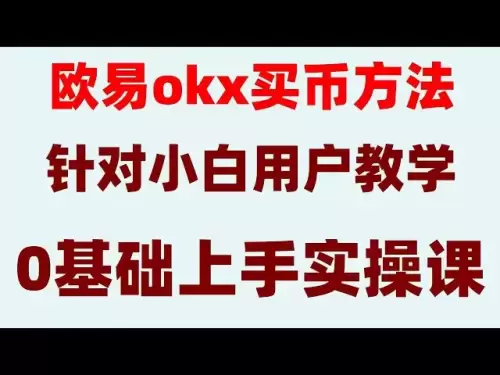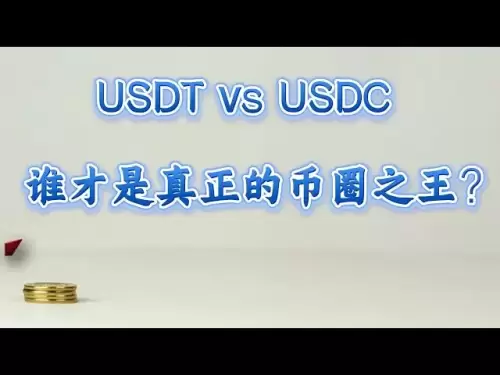-
 Bitcoin
Bitcoin $110,982.3226
2.62% -
 Ethereum
Ethereum $2,639.0938
5.33% -
 Tether USDt
Tether USDt $1.0003
-0.01% -
 XRP
XRP $2.4210
1.59% -
 BNB
BNB $680.4494
1.57% -
 Solana
Solana $178.4495
5.14% -
 USDC
USDC $0.9998
0.00% -
 Dogecoin
Dogecoin $0.2398
4.46% -
 Cardano
Cardano $0.8003
5.03% -
 TRON
TRON $0.2750
3.12% -
 Sui
Sui $3.8227
-1.54% -
 Chainlink
Chainlink $16.6574
4.64% -
 Hyperliquid
Hyperliquid $32.7355
18.26% -
 Avalanche
Avalanche $24.9418
9.71% -
 Stellar
Stellar $0.3022
4.17% -
 Shiba Inu
Shiba Inu $0.0...01519
3.56% -
 Bitcoin Cash
Bitcoin Cash $436.3360
7.77% -
 Hedera
Hedera $0.2036
3.64% -
 UNUS SED LEO
UNUS SED LEO $8.9150
0.81% -
 Toncoin
Toncoin $3.1578
2.54% -
 Polkadot
Polkadot $4.8977
3.50% -
 Litecoin
Litecoin $99.5419
3.52% -
 Monero
Monero $401.3296
1.33% -
 Bitget Token
Bitget Token $5.2095
0.23% -
 Pepe
Pepe $0.0...01431
7.51% -
 Pi
Pi $0.8219
-1.01% -
 Dai
Dai $1.0000
0.02% -
 Ethena USDe
Ethena USDe $1.0005
-0.02% -
 Bittensor
Bittensor $466.2840
4.97% -
 Uniswap
Uniswap $6.3442
3.40%
How to identify false golden crosses and dead crosses with EMA?
Use EMA to spot false golden and dead crosses in crypto trading by checking volume, looking for divergences, monitoring price action, and analyzing market context.
May 22, 2025 at 10:49 pm
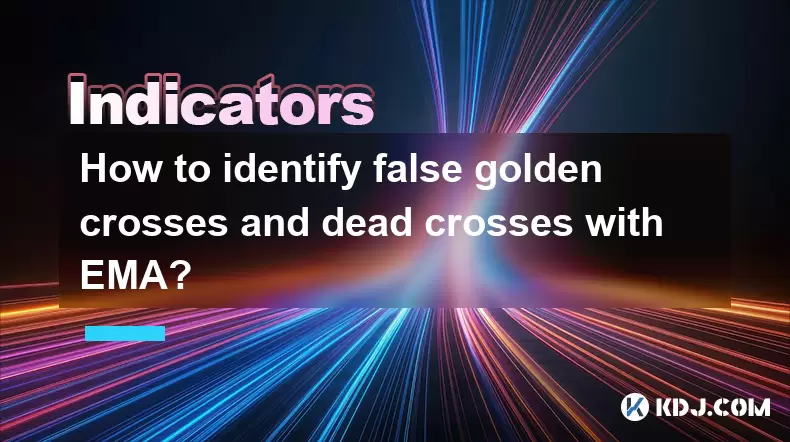
In the world of cryptocurrency trading, understanding technical indicators can be crucial for making informed decisions. Among these, the golden cross and the dead cross are two of the most widely discussed signals, often used to predict bullish and bearish market trends, respectively. However, false signals can lead traders astray. In this article, we will delve into how to identify false golden crosses and dead crosses using the Exponential Moving Average (EMA).
Understanding Golden Crosses and Dead Crosses
A golden cross occurs when a short-term moving average, such as the 50-day EMA, crosses above a long-term moving average, like the 200-day EMA. This event is considered a bullish signal, suggesting that the asset's price may continue to rise. Conversely, a dead cross happens when the short-term EMA crosses below the long-term EMA, indicating a potential bearish trend.
While these signals can be powerful, they are not infallible. False signals occur when the anticipated trend does not materialize after the cross. Identifying these false signals can save traders from making costly mistakes.
The Role of EMA in Identifying False Signals
The Exponential Moving Average (EMA) gives more weight to recent prices, making it more responsive to new information than the Simple Moving Average (SMA). This characteristic makes EMA a valuable tool for traders looking to identify false signals.
To effectively use EMA in spotting false golden and dead crosses, traders need to understand the context of the market and the behavior of the EMA lines. Let's explore the steps to identify these false signals.
Identifying False Golden Crosses
A false golden cross can occur when the short-term EMA crosses above the long-term EMA, but the price does not continue to rise as expected. Here's how to identify such false signals:
Check the Volume: A true golden cross is often accompanied by an increase in trading volume. If the volume does not increase significantly, it might be a false signal.
Look for Divergences: If the price is making higher highs but the EMA lines are not following suit, this divergence can indicate a false golden cross.
Monitor the Price Action: After the golden cross, observe the price action. If the price fails to break above recent resistance levels, it could be a sign of a false signal.
Analyze the Market Context: Consider the broader market trend. If the overall market is bearish, a golden cross might be less reliable.
Identifying False Dead Crosses
Similarly, a false dead cross occurs when the short-term EMA crosses below the long-term EMA, but the price does not continue to fall as anticipated. Here's how to identify these false signals:
Check the Volume: A true dead cross should be accompanied by a significant increase in trading volume. A lack of volume increase can indicate a false signal.
Look for Divergences: If the price is making lower lows but the EMA lines are not confirming this trend, it might be a false dead cross.
Monitor the Price Action: After the dead cross, observe the price action. If the price fails to break below recent support levels, it could be a sign of a false signal.
Analyze the Market Context: Consider the broader market trend. If the overall market is bullish, a dead cross might be less reliable.
Using Additional Indicators to Confirm Signals
While EMA is a powerful tool, using it in conjunction with other indicators can help confirm or refute signals. Some useful indicators include:
Relative Strength Index (RSI): The RSI can help identify overbought or oversold conditions, which can be useful in confirming or questioning a golden or dead cross.
Moving Average Convergence Divergence (MACD): The MACD can provide additional confirmation of trends and potential reversals.
Bollinger Bands: These can help identify volatility and potential price breakouts or breakdowns.
Practical Example of Identifying a False Golden Cross
Let's walk through an example of identifying a false golden cross using a hypothetical cryptocurrency, CryptoX.
Initial Observation: You notice that the 50-day EMA of CryptoX has crossed above the 200-day EMA, suggesting a golden cross.
Check the Volume: You observe that the trading volume did not increase significantly during the cross. This raises a red flag.
Look for Divergences: You see that while the price of CryptoX is making higher highs, the 50-day EMA is not following the same pattern, indicating a divergence.
Monitor the Price Action: After the golden cross, you notice that CryptoX fails to break above a recent resistance level at $500. This suggests that the bullish trend might not materialize.
Analyze the Market Context: The broader market is showing signs of a bearish trend, which could mean that the golden cross for CryptoX is less reliable.
In this scenario, the combination of low volume, divergence, failure to break resistance, and a bearish market context suggests that the golden cross for CryptoX might be a false signal.
Practical Example of Identifying a False Dead Cross
Now, let's consider an example of identifying a false dead cross using another hypothetical cryptocurrency, CryptoY.
Initial Observation: You notice that the 50-day EMA of CryptoY has crossed below the 200-day EMA, suggesting a dead cross.
Check the Volume: You observe that the trading volume did not increase significantly during the cross. This raises a red flag.
Look for Divergences: You see that while the price of CryptoY is making lower lows, the 50-day EMA is not following the same pattern, indicating a divergence.
Monitor the Price Action: After the dead cross, you notice that CryptoY fails to break below a recent support level at $200. This suggests that the bearish trend might not materialize.
Analyze the Market Context: The broader market is showing signs of a bullish trend, which could mean that the dead cross for CryptoY is less reliable.
In this scenario, the combination of low volume, divergence, failure to break support, and a bullish market context suggests that the dead cross for CryptoY might be a false signal.
Frequently Asked Questions
Q: Can the EMA period lengths be adjusted to better identify false signals?
A: Yes, adjusting the period lengths of the EMAs can help traders better identify false signals. For instance, using a shorter-term EMA like the 20-day EMA alongside the 50-day and 200-day EMAs can provide more granular insights into short-term trends and potential false signals. Experimenting with different period lengths can help traders find the combination that works best for their trading strategy.
Q: How can backtesting help in identifying false golden and dead crosses?
A: Backtesting involves applying trading strategies to historical data to see how they would have performed. By backtesting the identification of false golden and dead crosses, traders can refine their methods and better understand which indicators and conditions are most effective in spotting false signals. This can lead to more accurate predictions and better trading decisions.
Q: Are there any specific time frames that are more effective for identifying false signals with EMA?
A: The effectiveness of identifying false signals with EMA can vary depending on the time frame used. Shorter time frames, such as hourly or 4-hour charts, can be more sensitive to short-term fluctuations and may help identify false signals more quickly. However, longer time frames, like daily or weekly charts, can provide a more reliable view of the overall trend and may be better suited for identifying false signals in the context of broader market movements. Traders should experiment with different time frames to find what works best for their trading style and objectives.
Q: How can traders combine EMA with other technical analysis tools to improve their accuracy in identifying false signals?
A: Combining EMA with other technical analysis tools can significantly enhance a trader's ability to identify false signals. For example, using the RSI to check for overbought or oversold conditions can confirm or question a golden or dead cross. Similarly, the MACD can provide additional insights into trend strength and potential reversals. Bollinger Bands can help identify volatility and potential breakouts or breakdowns, adding another layer of analysis to confirm or refute EMA signals. By integrating multiple indicators, traders can build a more robust strategy for identifying false signals.
Disclaimer:info@kdj.com
The information provided is not trading advice. kdj.com does not assume any responsibility for any investments made based on the information provided in this article. Cryptocurrencies are highly volatile and it is highly recommended that you invest with caution after thorough research!
If you believe that the content used on this website infringes your copyright, please contact us immediately (info@kdj.com) and we will delete it promptly.
- Qubetics ($TICS), SEI, EOS - 3 Cryptos Primed to Explode as They Under $1
- 2025-05-23 04:35:15
- Sonic Labs Picks GSR as the Official Market Maker Partner for Its Native Token
- 2025-05-23 04:35:15
- Cryptocurrency markets are surging, driven by institutional demand and strong ETF inflows
- 2025-05-23 04:30:13
- The search for the next 100x memecoin is heating up again
- 2025-05-23 04:30:12
- Maxine Waters Introduces "Stop Crypto Corruption Act" Targeting President Trump's Memecoin
- 2025-05-23 04:25:13
- Democrats Target Political Crypto Activity with Stop TRUMP in Crypto Act
- 2025-05-23 04:25:13
Related knowledge
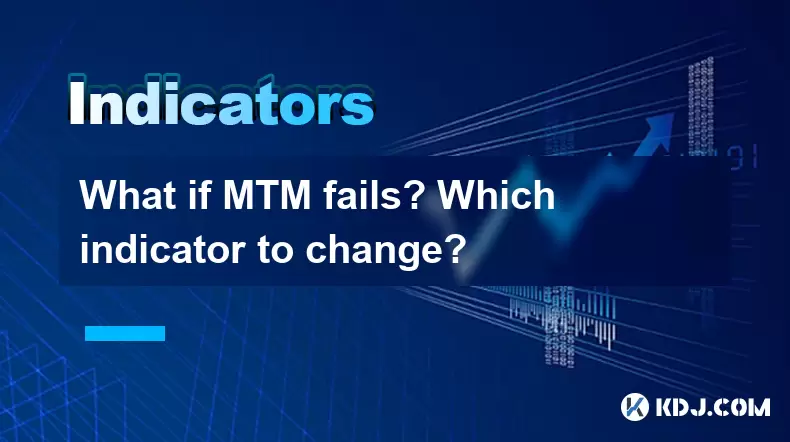
What if MTM fails? Which indicator to change?
May 23,2025 at 12:35am
Understanding MTM and Its ImportanceMoney Transfer Mechanism (MTM) is a critical component in the world of cryptocurrencies, especially when it comes to facilitating transactions between different parties. MTM ensures that funds move securely and efficiently from one wallet to another. However, like any system, MTM can sometimes fail, leading to delays,...
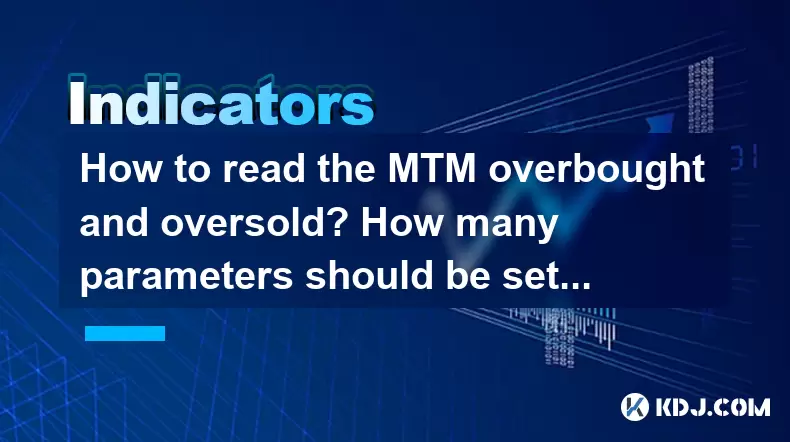
How to read the MTM overbought and oversold? How many parameters should be set?
May 23,2025 at 12:01am
Introduction to MTM IndicatorThe Money Flow Index (MFI), commonly referred to as the MTM (Money Flow Multiplier), is a momentum indicator that measures the strength of money flowing in and out of a security. It is similar to the Relative Strength Index (RSI) but incorporates volume, making it a more comprehensive tool for traders in the cryptocurrency m...
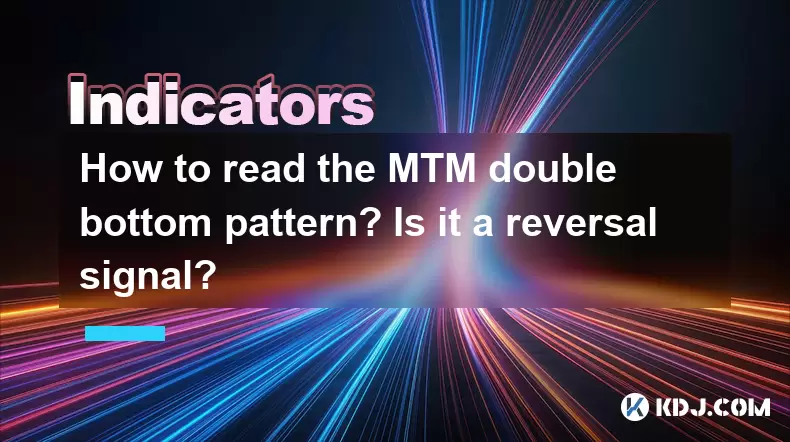
How to read the MTM double bottom pattern? Is it a reversal signal?
May 23,2025 at 03:21am
The MTM double bottom pattern is a technical analysis tool used by cryptocurrency traders to identify potential reversal points in a market trend. This pattern is particularly significant because it can signal a shift from a bearish to a bullish market, providing traders with opportunities to enter long positions. To understand and effectively read the ...
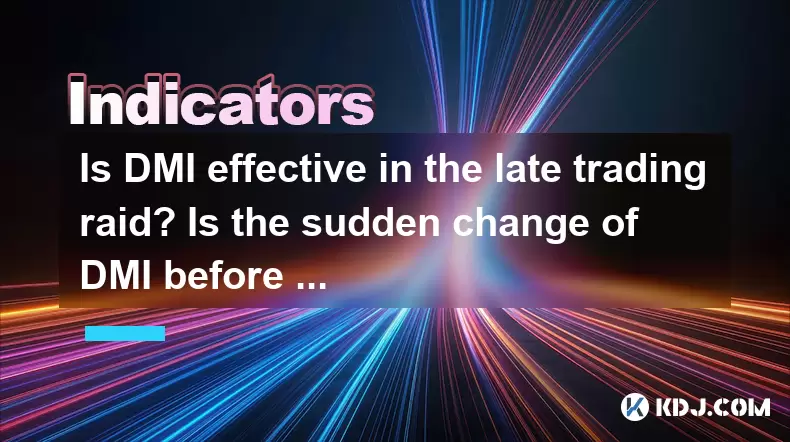
Is DMI effective in the late trading raid? Is the sudden change of DMI before the closing credible?
May 22,2025 at 11:07pm
Understanding DMI in Cryptocurrency TradingDirectional Movement Index (DMI), often referred to simply as DMI, is a technical analysis tool used by traders to assess the strength and direction of a price trend. In the context of cryptocurrency trading, DMI can be particularly useful for identifying potential entry and exit points. The DMI consists of thr...

How to use DMI in the gap position? Is the DMI signal effective after the gap?
May 23,2025 at 02:15am
Understanding DMI and Gap PositionsThe Directional Movement Index (DMI) is a technical analysis tool used by traders to assess the strength and direction of a price trend. It consists of three lines: the Positive Directional Indicator (+DI), the Negative Directional Indicator (-DI), and the Average Directional Index (ADX). The DMI is particularly useful...
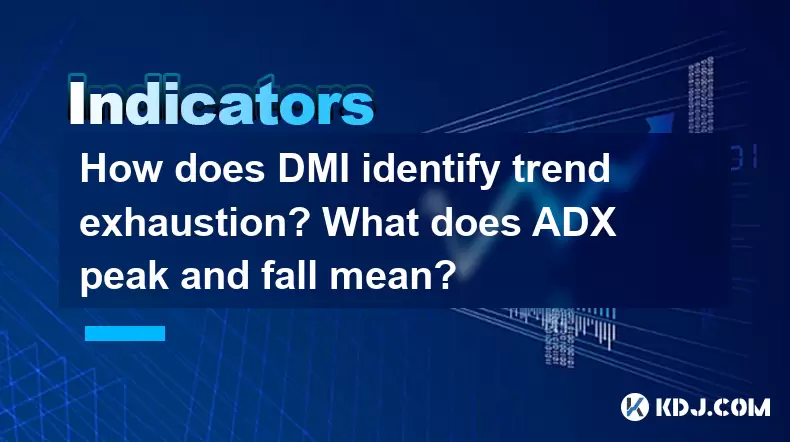
How does DMI identify trend exhaustion? What does ADX peak and fall mean?
May 23,2025 at 04:21am
Introduction to DMI and ADXThe Directional Movement Index (DMI) is a technical indicator developed by J. Welles Wilder to assess the strength of a price trend and identify potential trend exhaustion. It consists of three main components: the Positive Directional Indicator (+DI), the Negative Directional Indicator (-DI), and the Average Directional Index...

What if MTM fails? Which indicator to change?
May 23,2025 at 12:35am
Understanding MTM and Its ImportanceMoney Transfer Mechanism (MTM) is a critical component in the world of cryptocurrencies, especially when it comes to facilitating transactions between different parties. MTM ensures that funds move securely and efficiently from one wallet to another. However, like any system, MTM can sometimes fail, leading to delays,...

How to read the MTM overbought and oversold? How many parameters should be set?
May 23,2025 at 12:01am
Introduction to MTM IndicatorThe Money Flow Index (MFI), commonly referred to as the MTM (Money Flow Multiplier), is a momentum indicator that measures the strength of money flowing in and out of a security. It is similar to the Relative Strength Index (RSI) but incorporates volume, making it a more comprehensive tool for traders in the cryptocurrency m...

How to read the MTM double bottom pattern? Is it a reversal signal?
May 23,2025 at 03:21am
The MTM double bottom pattern is a technical analysis tool used by cryptocurrency traders to identify potential reversal points in a market trend. This pattern is particularly significant because it can signal a shift from a bearish to a bullish market, providing traders with opportunities to enter long positions. To understand and effectively read the ...

Is DMI effective in the late trading raid? Is the sudden change of DMI before the closing credible?
May 22,2025 at 11:07pm
Understanding DMI in Cryptocurrency TradingDirectional Movement Index (DMI), often referred to simply as DMI, is a technical analysis tool used by traders to assess the strength and direction of a price trend. In the context of cryptocurrency trading, DMI can be particularly useful for identifying potential entry and exit points. The DMI consists of thr...

How to use DMI in the gap position? Is the DMI signal effective after the gap?
May 23,2025 at 02:15am
Understanding DMI and Gap PositionsThe Directional Movement Index (DMI) is a technical analysis tool used by traders to assess the strength and direction of a price trend. It consists of three lines: the Positive Directional Indicator (+DI), the Negative Directional Indicator (-DI), and the Average Directional Index (ADX). The DMI is particularly useful...

How does DMI identify trend exhaustion? What does ADX peak and fall mean?
May 23,2025 at 04:21am
Introduction to DMI and ADXThe Directional Movement Index (DMI) is a technical indicator developed by J. Welles Wilder to assess the strength of a price trend and identify potential trend exhaustion. It consists of three main components: the Positive Directional Indicator (+DI), the Negative Directional Indicator (-DI), and the Average Directional Index...
See all articles






















